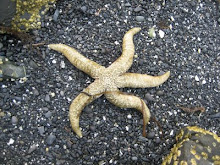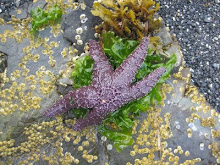......and he left his garment in her hand, and fled, and got him out!
While captaining whale-watching ships in Alaska, I saw something in nature that reminded me of escaping from evil or danger that I would like to share with you. I took the photo below of some Harbor Seals is Sitka Sound in the late 90's. As part of a native Alaskan's subsistence rights,they can hunt Harbor Seals. They take them for their oil, their meat, and their hide. Other than that they are a protected species. Of course, seals are mammals. They have a thick layer of blubber to keep them warm in the cold Alaskan seas. They have a thick hide to allow them to rest on the sharp and rugged, rocky outcroppings along the coast. Along with showing the tourists whales, bears, otters, sea-lions, and bird life, the harbor seal was a daily treat to encounter and share with the passengers.
The harbor seals spend their day feeding on fish. When they are done feeding they like to rest on rocks that are exposed during the low tide. Harbor seals are fairly easy to locate in the wild because they frequent the same rocky outcrops. They choose the location based on its ability to safeguard them from predators and danger. They always stay close to the edge of the water so that they can quickly escape.

During the busy tourist season in Sitka, Alaska, I would visit the seals on a regular basis.
Unless there was an uncommon circumstance, like Killer Whales in the area, at a dropping tide we could find the seals. The seals would get used to us day after day. We could get in close for photos but always stayed far enough off so that we didn't distract or startle them. From time to time a tourist would drop their camera and the resulting loud noise would scare the seals into the water. But in general, they knew they were safe.
Over centuries of hunting, the Alaska natives have perfected how to hunt and take seals. One technique that the natives use is to come up on the seals with the sun at their backs. That way they could sneak up on the seals because the sun would be in the seals eyes. One day I approached the seals with the sun at my back. I was amazed that the seals immediately scrambled down into the water. There was not a second of hesitation. They knew that when a boat approached from the sun, it spelled disaster. Although they knew our big, white tour vessels that never brought them any harm, the second that I approached in the sun, they scrambled. No hesitation, no confusion; they acted, they escaped. One moment they were there, the next, they were gone.
See how these seals are observant and ready to escape into the water if danger approaches.
As Priesthood holders, we have the responsibility of recognizing evil or danger, and then acting. Before my mission, my Dad blessed me that if I always "stood in holy places", I would always be safe and protected. While serving in Japan, I saw that blessing fulfilled often.
As a licensed Captain, I learned a great lesson about steering away from danger and possible collision while piloting vessels in the Inside Passage of Southeast Alaska. Some of the waterways there were quite narrow, and when you would approach another vessel coming right at you, sometimes both of you would turn the same direction and then confusion would result until you could communicate with the vessel by radio to find out the intention of the other vessels and then act accordingly. By the time you finally communicated, you could be too close for comfort. That scenario was the cause of many collisions at sea.
Captain James E. Barber, US Navy (Retired), author of the Naval Shiphandler's Guide,
says the following about confronting danger when piloting a vessel: "When maneuvering to avoid a developing situation it is important to 'signal with your bow' to make clear your intention to the other vessel. In a meeting situation a course change of two or three degrees may be sufficient for safe clearance but it is much better to make a ten or fifteen degree change that is clearly visible to the other vessel, then return to your course when the situation has clarified." In other words, let the other captain see your course change early, while at a safe distance let him see you swing the bow of your boat away from head-on courses so that he sees your intention and can know exactly what you intention is.
The way that this translates to our lives is that we should signal with our character and integrity while we are approaching other people so that when we meet, our intention of righteousness is clear. Learn to "signal with your bow", to avoid possible collision with evil and danger.
Females were always hyper vigilant to protect their pups.
May we be like Joseph and flee from danger and evil. May we "signal with our bow" our intention of righteousness and truth. Remember, swing wide!
Notice the Gray Whale in the foreground.
I took all of these photos while piloting a vessel like the one above in Sitka Sound. These high-speed catamarans have four engines and four water jets for propulsion. These vessels are very fast and very maneuverable.


























